Growing Jaboticaba in Hot, Dry Climates
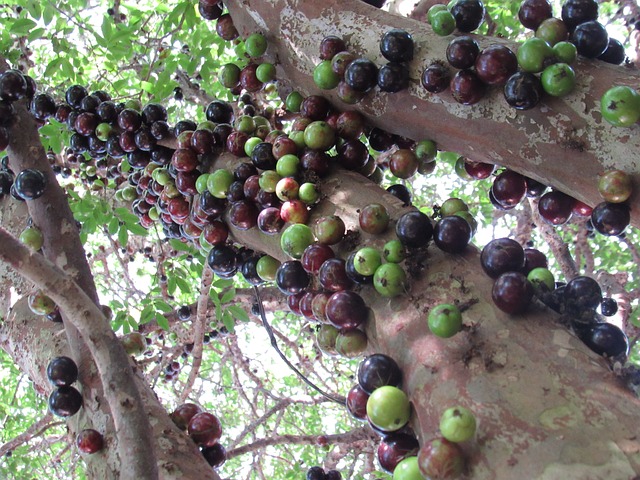
Jaboticaba is another one of those fruits that I haven’t had the chance to get my hands on here in the Phoenix area. Since, I haven’t had the chance to sample the fruit, I was hesitant about purchasing a tree. I found some cheap starter plants on eBay, so I figured I’d give one a shot.
I’ve seen a few mature Jaboticaba Trees in the Phoenix area, so I know it is possible to grow them in a hot, dry climate. There are a couple Youtube videos on some of those trees stating that they’re over 20 years old. They also consistently produce fruit in our area, which is something else that I like to hear.
Red Hybrid Jaboticaba
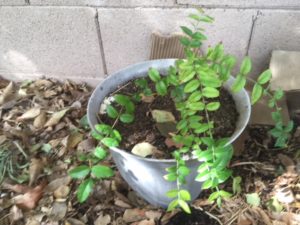
The Jaboticaba variety that I’m currently growing is the Red Hybrid variety. This variety is supposed to be more of a rapid grower, which produces fruit from seed in 3-5 years.
Jaboticaba tends to be more of a dwarf tree or shrub-like. Even still, it’s a super slow growing tree. A standard Jaboticaba can take up to 8 years before it starts producing fruit.
Growing Jaboticaba from seeds is a common way to propagate, but it takes a lot of patience for the fruit. It’s best to buy a mature tree if you have the money and know you’ll like the fruit.
It’s still an attractive tree even if you don’t like the fruit. Many people grow the tree for bonsai purposes. It has flaky looking bark similar to a guava trunk.
Fruit
The fruit forms on the trunk of the tree which is unique. The fruit is about the size of a cherry with a similar outer skin like a cherry, but thicker in texture.
The red hybrid has a dark cherry like color skin, where the standard jaboticaba is more purple. It is reported that both varieties have similar tastes, but the red is a bit sweeter.
The flesh is described as grape-like with a tropical taste. It looks similar to the flesh of a longan or lychee with a seed in the center.
The fruit is also used to make jams and sauces. Jaboticaba tends to fruit a couple times per year.
Gardening Skill Level
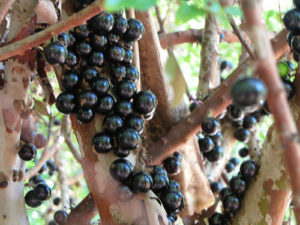
I would rate growing Jaboticaba trees in hot, dry climate as moderate skill level. They’re sensitive to our extreme heat, but our winters aren’t a problem.
They can handle cold down to the low 20’s. One major issue that I see with Jaboticaba is our saline water and high PH soil. They salt burn and get chloretic very easily. It’s somewhat similar to blueberries.
Suitable for Container Growing
Jaboticaba is a great tree to grow in a container. In fact, I would recommend growing it that way in a climate similar to my area.
I think it’s going to be able to control the soil PH to keep it more acidic so the tree continues to grow at a steady pace and get the nutrients it needs.
Typically, I would recommend a soil with good drainage for container growing fruit trees, but since Jaboticaba can handle staying in wet soils, I’ve kept mine in a soil mix that has a lot of peat moss.
I’m trying to make sure that the soil doesn’t dry out at all in our dry heat and keeping it more acidic. Jaboticaba grows so slow that it makes it easy to manage in a container.
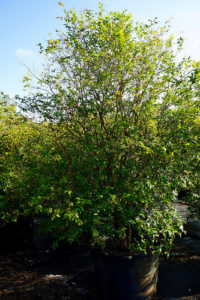
Planting Tips
A Jaboticaba is going to need some shade in our intense sun, so it’s going to require planting in an area that at least gets afternoon shade.
Watering
Jaboticaba really appreciates moist soil. I never allow my tree to dry out and root rot doesn’t seem to be a problem at all with Jaboticaba.
I kept my tree thoroughly watered throughout the year. It’s a good idea to flood the tree periodically to wash out the salts.
Feeding
Jaboticaba can show some deficiencies in our high PH soil. I tend to use soil sulfur throughout the year to help bring the PH down a bit. I also use Chelated Iron a few times per year.
Otherwise, I feed as usual with periodic applications or compost, fish emulsion, and liquid seaweed.
Here are some of my recommended products that I use.
Sun Exposure
Jaboticaba likes some sun, but not being exposed to all day full sun in our scorching heat. Like most tropical trees or just trees in general, afternoon shade goes a long way in our desert sun.
Growing Jaboticaba in a container the first year can allow you to move your tree around to find a good microclimate.
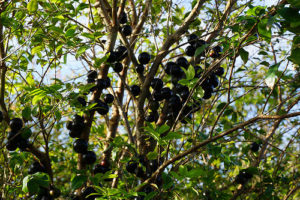
Potential Problems
I haven’t had much of a pest problem with my Jaboticaba. The main problem that I’ve had is salt burn and chlorosis of the leaves.
The tips of the leaves will turn brown and crispy. I continue to try to keep the soil acidic with sulfur and peat moss. Periodic applications of chelated iron also have helped.
I also recommend giving this tree adequate sun protection during the hottest parts of the year.
Please comment below on anything you enjoyed from this post or your experience with growing Jaboticaba trees in hot, dry climates.
photo credit: TreeWorld Wholesale Myrciaria Cauliflora (Jaboticaba Brazilian Grape Tree) via photopin (license)
photo credit: TreeWorld Wholesale Myrciaria Cauliflora (Jaboticaba Brazilian Grape Tree) via photopin (license)
photo credit: lotuspilgrim Jaboticaba Tree, Loosing a layer of bark and also fruiting. via photopin (license)
